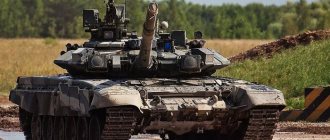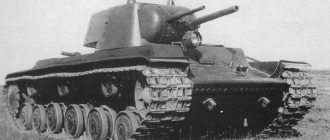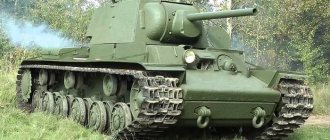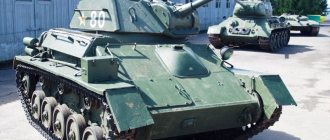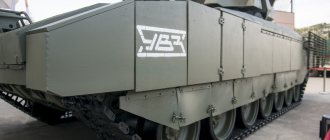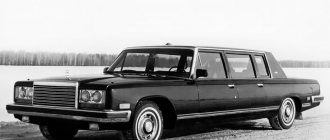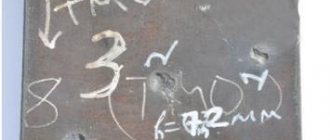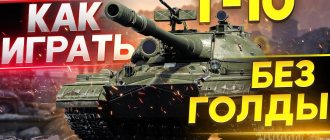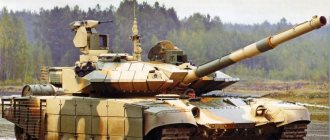After the collapse of the Soviet Union, hardly anyone seriously expected that Russia would be able to present the world with a new main battle tank in just a couple of years. Nevertheless, it happened, and for more than two decades the T-90 tank has been a star, a topic of heated discussion, both among experts and among amateurs.
Propaganda-oriented sources immediately rushed to declare it superior in all respects to its possible competitors. Skeptics declared the T-90 deliberately outdated. The actual absence of this combat vehicle among the troops and the promise of designers from competing factories to provide more advanced models (the “Black Eagle” project) added fuel to the fire. Now that operating experience has been accumulated, it is already possible to draw conclusions about who was right.
Brief history of creation
The fleet of armored vehicles of the Soviet troops in the eighties was distinguished by its diversity. In service at the same time were: the first-born of the Soviet MBT T-64, a cheaper and more technologically advanced competitor to the T-72, a representative of the new generation T-80 with a gas turbine engine, and its diesel “relative” T-80UD, and these are just the main ones.
In addition to them, the modernized “old men” T-55 and T-62 also remained in service.
The T-80 was considered the most modern and efficient, but at the same time it turned out to be expensive and difficult to manufacture and operate. In 1988, work began to bring the reliable and trouble-free T-72 to the required efficiency.
In the spring of 1991, the experimental “Object 188” was recommended for adoption.
It was supposed to be called “T-72BU”, but it never made it into the Soviet army. It became the newest vehicle of the Russian army, and was christened the T-90.
The name change is associated with the desire of Russian President B. Yeltsin to have a completely new tank. It is also possible that after the war with Iraq in 1991, the reputation of the T-72 was seriously tarnished, and the new designation could help sell the equipment for export.
Vehicles based on the T-80 tank
- Self-propelled artillery unit Msta-S .
- Self-propelled artillery unit 2S7 Pion.
- Combat modules of the S-300V .
- Special crawler-mounted fire truck SPM .
- Armored repair and recovery vehicle BREM-80U .
- Floating conveyor PTS-4 .
- Trench excavator BTM-4M .
152-mm divisional self-propelled howitzer "Msta-S", also the "sister" of the T-80
Also, based on the main tank T-80UD, the following were developed:
- Ukrainian main tank T-84 (T-80UD with a souped-up engine, new aiming devices and dynamic protection).
- “Object 478DU9”, aka T-84U, aka T-84U “Oplot” (T-84 with a modified turret, installation of modern foreign surveillance devices and enlarged side screens).
- BM "Oplot" (aka "Oplot-M") is a further development of the T-80UD concept, a modern main tank.
• Directory of armored vehicles • Equipment of the same period •
Source: compilation based on publicly available information on the Internet
Tank structure
The T-90 hull is welded from armor sheets, the turret of early models is cast. The length of the hull (without a gun) is 6.8 m. Later modifications had welded turrets. The frontal armor of the hull (upper part) is made of combined armor, installed at an angle of 680. The sides, 70-80 mm thick, are vertical, without slope. This is higher than most analogues (although it protects equally poorly from being hit by an armor-piercing projectile).
The sides are covered with rubber-fabric screens, partially with dynamic protection units. For additional protection, it is possible to install anti-cumulative grilles, which have become widespread in the last decade.
In the design of the T-90 turret, combined armor is used to protect the frontal projection, and partially the sides and roof.
The height reaches 2.2 meters, and the T-90 weighs about 46 tons.
The T-90 was equipped with the Shtora active protection system. If it is irradiated by a guidance laser, the Shtora notifies the crew about this and fires aerosol grenades. The resulting smoke screen not only camouflages the tank visually, but also scatters the laser beam.
The first dynamic protection that appeared on the T-90 was designated “Contact-5”. It did not protect against tandem charges and did not improve resistance against armor-piercing shells. The newest model of the Relikt defense complex, which the T-90AM received, reduces the armor penetration of enemy shells by 40% and protects against heavy ATGMs with a tandem charge. In addition, modernized blocks for the Contact system raise its efficiency to almost a “relic” level.
The dense layout has a negative impact on survivability - fuel tanks have to be placed in the fighting compartment. However, in later modifications they were isolated from the crew by steel bulkheads. The automatic loader remains vulnerable - it is located behind the weakly protected side directly under the crew. We can say that the commander and weapon operator are sitting on the shots.
Crew accommodation has remained unchanged since the introduction of the T-64. The driver's seat is located in the front center of the body. The gunner is located on the left half of the turret, and the tank commander is located to the right of the gun.
The T-90 inherited the power plant from the T-72.
This is a multi-fuel 12-cylinder diesel engine V-84MS with a volume of 38.8 liters and developing 840 hp. In the T-90A modification, the engine was replaced with an improved version of the B-92, based on the same block. Its power reaches 1000 hp. With. The transmission is 7-speed and includes separate planetary gearboxes. Hydraulic drives are used to facilitate control. The T-90 has a torsion bar suspension and hydraulic shock absorbers.
Main battle tank of Russia T-90 (part 2)
Any borrowing and use of this material is only with the permission of the author
<<< See previous part
T-90K – commander version
Based on the Order of the State Military-Industrial Commission of the USSR dated April 4, 1991, within the framework of the Sambuc R&D [38NIIII Ministry of Defense of Russia. 75 years of research and testing of armored weapons and equipment. Ed. Fedoty V.I. Kubinka, 2006], the design bureau began designing a command version of the T-90 tank, which received the name “Object 188K” in experimental development. The tank is designed to perform the functions of controlling subordinate units, communicating with higher commanders, as well as for conducting combat operations as part of units and subunits and flexible control of units during combat operations both day and night.
The main volume of general layout work on the command item was carried out by leading designer V.I. Bundin. The number of fire control system units and communications equipment placed on the Object 188K has increased significantly compared to the command version of the T-72B tank. In this regard, V.I. Potkin, serious concerns arose about the possibility of acceptable placement of all the necessary equipment on the new product. However, thanks to the painstaking and fruitful work carried out in the shortest possible time at the design bureau, this complex issue was successfully resolved.
The main general machine characteristics of the T-90K tank were performed at the level of the characteristics of the base T-90 tank. The power plant, transmission, chassis, weapons, surveillance devices, armor protection, heating system, equipment for underwater driving, equipment for self-digging, equipment for installing a mine trawl are made the same as on the T-90 tank. In addition to the standard equipment, special equipment of the T-90K tank, which ensures the control function, includes: KB radio station R-163-50K, whip antennas, a set of KB antennas installed on an 11-meter telescopic mast; tank navigation equipment TNA-4-3, artillery compass PAB-2M; additional electric unit AB-1-P/28.5-V-U, power 1 kW.
The KB radio station is designed to provide radio communications in command networks in the frequency range 2...30 MHz when stationary and on the move. The radio station provides two-way telephone and telegraph communication, auditory and automatic reception of tone call signals, reception on a rotating antenna 4 m high at a range of up to 50-80 km. The number of pre-prepared frequencies is 16. The design of the HF whip antenna support allows it to be installed in an inclined position. In this position, the antenna is additionally supported by a special spring attached to the tower. This position of the antenna turns it into an “anti-aircraft radiation antenna”. The use of an “anti-aircraft radiation antenna” is effective when organizing communications in mountainous areas. A “symmetrical vibrator” antenna installed on an 11-meter mast in the range of 2…18 MHz provides a communication range of up to 350 km. The radio station also provides modes: dual-frequency simplex, standby reception with scanning on recorded frequencies, receiving and transmitting an address call, receiving and transmitting codegrams.
Tank navigation equipment is used to determine the location of a tank or unit on the ground, the direction of movement, and the distance to a given destination. The equipment consists of a gyro direction indicator, a control panel, a coordinator, and a remote (indicating) tablet for a topographic map. The equipment provides determination of the tank’s coordinates with high accuracy based on the distance traveled without reorientation, and solves the following navigation problems:
• automatic determination of tank coordinates;
• automatic determination of the tank's directional angle;
• automatic determination of the directional angle to the destination;
• indication of the tank's location on a topographic map;
• automatic determination of differences between the coordinates of the tank’s location and the coordinates of the destination. The PAB-2M compass is used to determine the directional angle in conditions of poor visibility and in the absence of visible landmarks.
The electric unit is an auxiliary generating set driven by a carburetor engine and is intended to power consumers during parking when the main engine is not running. [Yamov V.A. Op. op.]
After completion of the tests, on the basis of the order of the Minister of Defense dated June 3, 1994, the “Object 188K”, receiving the name T-90K tank, was adopted by the Russian Army. [Kolmakov D.G. Op.cit. P.67.]
T-90S – machine for export
Simultaneously with the work on the base vehicle “Object 188”, work was underway on the creation of an export version of the T-90 tank - “Object 188S”, authorized for delivery abroad by decree of the President of the Russian Federation dated December 24, 1992 under the name “T-90S”. The main difference between the T-90S and the T-90 was a slight decrease in the level of protection. However, this is a traditional solution for export vehicles. However, even in this form the car was very well protected. In addition, there were minor differences in the configuration, and all service inscriptions were made in English. The very first samples of the “eSki” ended up in Russian tank schools, where crews from the countries that imported our military equipment underwent training and retraining. One of the educational institutions that was among the first to receive the T-90S was the Chelyabinsk Tank Institute [Russia's main battle tank T-90. DVD with photo overview and tips for scale modeling. Model Point LLC with the participation of DiAl LLC, 2008]. However, there was a hitch with the deployment of widespread exports - this car did not receive active promotion to the markets at that time. The state, together with Promtekhexport, relied on the T-80U, considering it more attractive for export. For these reasons, the presentation of the car at the IDEX'93 exhibition was disrupted. At a meeting regarding the participation of the Russian delegation in the exhibition, held on October 11, 1992 in Moscow at the Department of Defense Industries of the Government of the Russian Federation, the proposal for the participation of the T-90S was watered down - UVZ and UKBTM were allowed to demonstrate only the T-72S. The Tagil residents did not give up and punched their car with all their might. The first presentation of the T-90S took place in June 1997 at the IDEX'97 exhibition in Abu Dhabi (UAE). Since that time, the T-90S has become an indispensable participant in many exhibitions and weapons shows.
T-90S model 1999 [*] – demonstration models
[* Kolmakov D.G. “The legendary “thirty-four”. N. Tagil, 2006; V. Yamov, S. Ustyantsev, D. Kolmakov. Combat vehicles of URALVAGONZAVOD. Popular series. “Armored vehicles of URALVAGONZAVOD. Retrospective 1941-2009". Manuscript.]
Over time, the technical appearance of export T-90S models has changed somewhat. An indispensable condition for success was equipping tanks with better and more advanced thermal imaging sighting systems. It is no secret that the USSR, and its successor, the Russian Federation, had big problems with the development and production of modern optical-electronic equipment. The level of Soviet scientific and technical developments remained traditionally very high, but the industry and the element base failed. In the 1990s, Russia developed the Agava and Nocturne thermal imaging sights for tanks. However, the release of "Agave" was extremely limited, and "Nocturne" existed only in prototypes. At the same time, the development and production of thermal imaging equipment in the West was carried out at an increasing pace, and was one of the highest priority areas. Russian tank builders unwittingly had to turn to the experience of foreign companies. The first steps in this direction were taken back in 1993. Israeli and French samples attracted the most attention. As a result, thermal imaging devices developed by Peleng OJSC (Republic of Belarus) were installed on the new demonstration samples of the T-90S, which used a French Catherine-FS thermal camera and Thompson television monitors.
The design of the tower has undergone very serious changes. By the end of the 90s, due to the lack of government orders for new equipment, the production of tower casting in Russia was curtailed. Casting towers in small batches has become extremely unprofitable. In this situation, the groundwork for work on the production of tank turrets by welding rolled armor plates came in handy. The design of such a tower was developed by UKBTM in the late 80s - early 90s jointly with the Moscow Research Institute of Steel and was tested on a number of experimental machines. Rolled armor plates provided, with equal protection strength, less metal consumption and, accordingly, less weight of the structure. In addition, the internal volume has increased slightly, which made it possible in the future to use new, longer sub-caliber ammunition with armor penetration increased by 20%. Despite the fact that the labor intensity of manufacturing such a tower increased, the cost of its production still remained lower than when casting in small batches. The first experimental vehicles with welded turrets were manufactured in 1998. One of them passed full-scale shelling tests at the training ground 38NIIII of the RF Ministry of Defense. Since 2002, the welded turret began to be installed on all produced models of the T-90S tank. The cast “cap” remained only on cars undergoing conversion from the early ones produced.
In 1998-99, the T-90S received a new power plant with a 1000-horsepower multi-fuel four-stroke diesel engine V-92S2 produced by ChTZ. The introduction of the B-92S2 was preceded by a lot of work by the tank design bureau together with the engine design bureau. A wide variety of diesel engines were tested using an experimental setup on benches and machines. One of the most promising models for the T-90 was the Barnaul turbo-diesel KD-34. However, in the final stages, its place was taken by the Chelyabinsk B-92S2. This turbocharged diesel engine has undergone comprehensive stationary testing at plant benches, and was also tested as part of T-90 prototypes in a variety of climatic conditions and has shown high reliability. The tank has significantly improved its dynamics.
The changes also affected the chassis of the car. The requirements for improving mobility, as well as the requirements for driving on asphalt roads without destroying their surface (especially relevant for potential importers) led to the need to install a new caterpillar track with a parallel track. Unlike the “old” caterpillar with sequential engagement of the tracks, it had the ability to install so-called “asphalt shoes”. Externally, the new caterpillar is very similar to that of the T-80, but there is one very important and fundamental difference between them: the T-80 caterpillar has a rubber-coated treadmill, while the T-90 track has a steel treadmill. This gives a big cost advantage, especially considering that the track is a resource part. In addition, during the interaction between the metal of the treadmill and the rubber band of the road wheel, lower friction losses occur than during the “rubber-to-rubber” interaction on the T-80. This gives a gain in fuel efficiency due to lower power losses and savings in terms of large resources of roller tires and caterpillar tracks [Vavilonsky E., Kuraksa O., Nevolin V. Main battle tank of Russia. A frank conversation about the problems of tank building. N. Tagil. 2008 pp.91-98]. Since 1996, a new caterpillar has been installed on all T-90 models [Khlopotov A. Tank T-72BA: mediocre modernization or affordable modernization? Magazine "Equipment and Weapons" No. 10 2009]. And it was with just such a caterpillar that the T-90S performed at its premiere at IDEX'97.
In addition to the standard navigation systems, the T-90 now has a modern satellite navigation system. To facilitate the work of the driver, folding mirrors and a rear view video camera are installed [Yamov V.A. Op.cit.; The main battle tank of Russia is the T-90. DVD with photo overview and tips for scale modeling. Molel Point LLC with the participation of DiAl LLC, 2008].
Another new system tested on demonstration samples of the T-90S with a welded turret was the SEMZ - electromagnetic protection system. SEMZ is intended for protection against mines with a non-contact magnetic fuse, by inducing a false magnetic field outside the projection of the vehicle body, which leads to premature detonation of the mine.
The VDZ complex remained unchanged, only the number of blocks on the roof of the turret changed - now there are 17 of them. The launchers of the "Tucha" system are located somewhat differently than on the T-90S with a cast turret - only 4 launchers are installed on the right console, and 2 more are located on the roof of the tower.
The first public demonstration of the T-90S with a welded turret, a thermal imaging sighting system and a power plant with a V-92S2 diesel engine took place at the UralExpoArms - 1999 arms exhibition at the FSUE NTIIM training ground in July 1999. In 2000, for demonstration at the exhibition in Nizhny Tagil “RussiaExpoArms - 2000”, the tank was equipped with the “Cape” camouflage kit developed and produced by the Steel Research Institute. In the working documents of the exhibition, this machine was designated “Object 188SM”, which gave journalists a reason to conditionally call this option as “T-90M” or “T-90SM” [Exhibition “Ural Expo Arms 2000” in Nizhny Tagil. Magazine "Tankmaster" No. 4, 2000].
See continuation >>>
Join our group “Courage 2004”
Share on social networks:
T-90 armament
The main caliber of the tank is the “traditional” 125mm Rapier cannon for Soviet and then Russian vehicles. The T-90 received its version 2A46M-5, the accuracy of which (compared to older versions) was increased by 15-20%. The gun stabilizer was two-plane.
The carousel-type automatic loader was inherited from the T-72, but can now be controlled from the commander’s seat. There are 22 shots placed in the “carousel”, the rest (up to 43 in total) are stored in the housing. The crew either loads the gun itself with them, or can reload the automatic loader.
To destroy enemy armored vehicles, the T-90 uses armor-piercing sub-caliber projectiles, for example, 3BM46 with a uranium core. The effective range when firing such projectiles is up to 3000 m. The loading system of the T-90S tank has been redesigned and allows the use of the latest high elongation projectiles, such as 3BM60. To increase the effectiveness of hitting infantry in shelters, a fragmentation projectile with the possibility of detonation in the air and ready-made submunitions was developed.
An alternative to sub-caliber “blanks” can be the 3BK31 cumulative projectile, the triple warhead of which can overcome double dynamic protection. The T-90 can launch guided missiles through its gun barrel. The laser-guided 9M119M "Invar" ATGM has a tandem cumulative warhead with armor penetration (normal) up to 700 mm. The ammunition can be supplemented with missiles with high-explosive and thermobaric charges. The missiles will allow you to hit a moving target at distances of up to 5000 m.
The cannon, as on previous tanks, is paired with a 7.62mm PKT machine gun.
Its ammunition capacity is eight 250-round cartridge belts, and its practical rate of fire is up to 250 rounds per minute. The first production vehicles had a remote-controlled NSVT heavy machine gun as an anti-aircraft gun. Later it was replaced by a similar in appearance, but different in design, KORD machine gun.
Electronic equipment
The Irtysh fire control system was inherited from early tanks from its predecessor, the T-80. But the already modified T-90A tank received a new fire control system (FCS) 1A42. It includes an aiming and rangefinder guidance device (combining a laser rangefinder with a sight) and an automatic electronic ballistic computer 1B528-1.
The T01-K04 observation device makes it possible to fire not only from an anti-aircraft machine gun, but also from the main gun. At night, it can operate in both passive and active (with target illumination by an IR illuminator) mode.
In subsequent series, the control system was modernized, and modifications of the AM (SM) tank received the latest Kalina system. This multifunctional complex combines not only sights and computers - it integrates the tank into the electronic battalion control system, increasing the efficiency of interaction with other armored vehicles and infantry.
Thermal imagers of early machines were early models and were significantly inferior to similar foreign ones.
On later series (and some export versions), French-made thermal imagers were installed. For communication, the R-163-50U radio station operating in the VHF range is used. Commander models received, in addition, a shortwave radio with a range of up to 50 km.
Tank fire control
Firing in the T-14 is controlled by an aiming system. Its main advantages:
- Availability of sighting and built-in laser control channels, range finder
- Possibility of adjusting the sighting channel with a magnification of 4 to 12
- The range at which the object is recognized is 5 km
- The maximum distance measured by the rangefinder is 7.5 km
- Equipment for a backup sight on the dependent sight line
- Ballistic computer device
- Automatic target tracking
- Advanced weapon stabilizer
The tank is equipped with radars based on an AFAR antenna array, consisting of a large number of cellular microwave transmitters. Such an antenna has the ability to quickly change the location direction.
Performance characteristics
The table shows the technical characteristics of the T-90A, as the most common model, and its closest analogues and competitors.
| T-90A | Leopard 2A6M | Challenger 2 | |
| Length/Width, mm | 9530/3780 | 6670/3700 | 11570/3520 |
| Combat weight, t | 46,5 | 68,5 | 62,5 |
| Crew, man | 3 | 4 | 4 |
| Main weapons, ammunition | 125mm smoothbore gun 2A46M-5, 43 rounds | 120mm smoothbore gun Rh-120, 42 rounds | 120 rifled gun L30E4, 52 rounds |
| Automatic loader | Eat | — | — |
| Auxiliary weapons | 1 x 7.62 mm PKT machine gun, 1 x 12.7 mm KORD machine gun | 2 x 7.62 mm MG3 machine guns | 2 x 7.62 mm L94 and L37 machine guns |
| Guided weapons | Reflex-M | — | — |
| Suspension | Torsion bar | Torsion bar | Hydropneumatic |
| engine's type | 12-cylinder diesel V-92S2 | 12-cylinder diesel MB 873 | 12-cylinder diesel CV-12 |
| Power plant power, l. With. | 1000 | 1500 | 1200 |
| Maximum speed, km/h | 70 | 72 | 56 |
| Cruising range, km (on highway) | 550 | 550 | 400 |
According to the figures, the Russian tank is equal to its competitors in terms of speed and reserve. In terms of strategic mobility, it is superior due to its lower weight and dimensions, making it easier to transport. It is possible that a more advanced Leclerc automatic loader could give it some advantages in battle due to its high rate of fire.
It is also worth mentioning that the T-90’s loading system had to be modified to allow the use of new shells (of greater length), limiting the combat capabilities of early tanks.
The advantage of Russian tanks (not only the T-90) is the presence of a standard fragmentation projectile.
Most Western competitors consider a cumulative fragmentation projectile to be a “multipurpose” ammunition, while the British still use armor-piercing high-explosive ones. On the other hand, the Americans developed both grapeshot and concrete-piercing shells for the Abrams.
Guided weapons are still not widely used (one can only name the Israeli LAHAT missiles). At the same time, there are still no known cases when a tank had to use an ATGM in battle.
Powerplant, transmission and control
The tank's power plant is based on a domestic diesel engine of the A-85-3A brand. Its resource is no less than 2000 hours. Specifications:
- Engine type – X-shaped, 12-cylinder, four-stroke with gas turbine supercharging and intermediate air cooling
- Mixture formation - fuel injection
- Power – 1500 hp
- Weight – 1550 kg
- Dimensions: length – 813 mm, width – 1300 mm, height – 820 mm
- The Armata's suspension is controlled, 6-roller, with vane shock absorbers. The differential mechanism is equipped with a hydrostatic transmission. The 12-speed automatic transmission can be shifted manually. The controls include: a steering wheel, brake and gas pedals, and a gear shift lever.
Modifications
The T-90 linear tanks were followed by a command version - the T-90K, equipped with an additional radio station and navigation system. Since 2004, deliveries of the T-90A with a more powerful engine, reinforced armor and improved thermal imagers began. In 2006, this tank also received a command version, the T-90AK, also with more powerful radio navigation equipment.
The “Breakthrough” project led to the appearance of seriously redesigned T-90 tanks. The T-90AM modification turret received a compartment to accommodate additional ammunition. Other changes include a steering wheel instead of control levers and a transmission that automatically changes gears.
And the T-90M version received a new 2A82 cannon and a different layout - the fuel tanks and ammunition were moved to increase survivability.
Separately, it is worth mentioning tanks created specifically for export. The T-90S and T-90SK were generally similar to the original T-90, but the Shtora system searchlights were not installed on them. The T-90SA and T-90SKA models were produced especially for Algeria. Modified for licensed assembly in India, the T-90 even received its own name “Bishma”.
The newest tank for export deliveries received the T-90SM index, and according to its data corresponds to the T-90AM tank. The T-90 chassis was used to build engineering equipment: artillery “self-propelled guns” and MLRS. The original “Fire Support Combat Vehicle”, which covers tanks in battle, deserves special mention.
Use in battles and traces in the history of tank building
There are statements about T-90s participating in the first campaign in Chechnya, but there is no documentary evidence of this. But his participation in the Syrian conflict is a fact. T-90 tanks of the Russian army are used in Syria.
For more than two years, only 2 tanks were lost, and 2 more were disabled.
A video has become famous showing a T-90 remaining intact after its turret was hit by a TOW missile. But a published photo of a T-90 with a torn off turret proves that the ammunition rack remains its vulnerable zone.
Perhaps it would be correct to say that the T-90 itself is “a mark in the history of tank building.” The trail left behind by the ideas first materialized in the T-64. The T-90 absorbed all the best from its predecessors - the reliability of the T-72, the technical “advancement” of the T-80.
The T-90 tank became the best and most powerful vehicle in this development ladder. And at the same time it marked its completion, when a completely new T-14 tank was developed. At the same time, in terms of its combat qualities, the T-90 continues to remain at a high level, and is not in danger of being removed from service soon.
It’s very easy to criticize the T-90, calling it “just a modernization of the T-72.” But both the Abrams and the Leopard are not new tanks at all, but modifications of “themselves” from 30 years ago.
Irony: if the tank had retained the T-72BU designation, no one would have claimed that the old vehicle was being passed off as a new one.
Of course, the T-90 was not intended for counter-guerrilla warfare, but, firstly, none of its competitors (with the possible exception of the Merkava tank) were also intended for these purposes. Secondly, in Syria the T-90 shows itself with dignity. And the continuity of the design ensured the possibility of producing the tank in difficult years for the country. Today it is among the best examples of tanks, and this is indisputable.
Comprehensive protection system
The protection system of the T-14 tank consists of several components:
- Armor protection. The new tank on the Armata platform is protected by specially developed armor steel. Its characteristics make it possible to reduce the thickness of the sheet and the overall weight of the structures.
- Active protection "Afganit", adopted for implementation in 2014. Specially designed charges are fired against enemy shells and missiles, hitting them at a distance of no more than 20 meters. The launcher is made of a carriage that rotates in horizontal and vertical planes. The impact core is aimed at the target using programmed initiation of fuses.
- Dynamic protection. Its essence lies in the fact that three blocks are installed on the sides of the tower. These are containers with dynamic protection elements that are separated by filler. The sides are protected by installing seven similar blocks. The aft area is covered with lattice screens on the hull and turret. Installed before military operations in special cases, for example, in urban conditions. The additional weight amounts to almost a ton, but this does not significantly reduce the mobility of the tank.
The T-14 is not just a new tank, it determined the prospects for tank building in Russia for decades to come. In the coming years, it is planned to produce at least 2-3 thousand tanks of this type and armored vehicles based on it.
